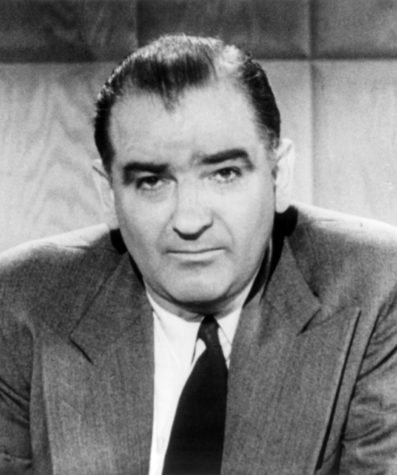Fear
December 6, 2017
The emotion of fear is a double-edged sword. It keeps humans away from potentially dangerous situations, but can also be destructive. Countless deaths can be attributed to nothing but fear, and many would say that these deaths could have been prevented had reason and logic prevailed.
Fear and suspicion are infectious and can produce mass hysteria that destroys public order and rationality. This idea has been reflected many times in society, as well as the literature that history has produced. The messages of the articles “The Roots of Fear” by Sharon Begley and “Again They Drink from the Cup of Suspicion” by Arthur Miller further prove this sentiment.
“Again They Drink from the Cup of Suspicion”, an editorial piece by Arthur Miller, reflects upon life during and after the McCarthy era. After the Second World War, Joseph McCarthy of the Republican Party exemplified the embodiment of American conservative ideology at the time by condemning those of any political affiliation towards the left of his. His actions “helped scatter the left-liberal coalitions” (Miller 1). McCarthy’s plan of accusing people of being communists and equating them to demons led to the American populace becoming afraid and mistrusting.

Arthur Miller’s article discusses how McCarthyism changed the American mindset when it says “the anti-communist crusade showed signs of becoming the permanent derangement of the American psyche” (2). The article reflected American society during a time where rationality was forgotten, while fear and suspicion triumphed.
The Crucible, a play written by Arthur Miller, acts as an allegory for the McCarthy era, and also demonstrates the horror of the Salem witch trials. In the play, Miller argues that “the witch-hunt was a perverse manifestation of panic”, which explains how fear of the unknown led to the deaths of dozens of innocent people, including well-respected members of the Salem community (1237). This is similar to McCarthyism because millions of Americans suddenly became afraid of communists, despite not knowing what communism even is. This fear led to the persecution of many innocent and previously trusted people, as it did in The Crucible.
During the events of The Crucible, as well as the time period it is an allegory for, fear and suspicion led to the destruction of public order. John Proctor, an upstanding inhabitant of Salem, said that “God damns our kind especially, and we will burn together” (Miller 1315). The demonstrates the loss of faith in the people of Salem due to the destructive power of the witch hunt, and that the fabric of society would be lost along with it.
One historical example that supports the idea of fear and suspicion leading to the destruction of rationality is the rise of Adolf Hitler. After World War I, Germany faced sever economic problems. Adolf Hitler, wanting to gain political power in Germany, chose Jews and communists as the scapegoats for these problems. Desperate for any bit of hope they could get, the German people went along with Hitler’s hateful rhetoric and began discriminating and persecuting anyone who they deemed to be “sub-human”. These events show how fear, whether or not there is credible reason for it, can lead to the breakdown of public order.
Another historical example of fear resulting in mass hysteria is the internment of Japanese-Americans after the assault on Pearl Harbor in 1941. The American government and its citizens became afraid of the possibility of Japanese spies existing in America, despite their being little evidence to support this idea. Besides that, thousands of Japanese families living in America were forced into internment camps where they lived under harsh conditions. This tragedy was the result of mass hysteria caused by fear and suspicion.
“The Roots of Fear”, an article written by Sharon Begley, explains why people feel fear and how fear can be used. A major part of Begley’s article is the political application of fear in order to gain power. The article states that politicians who exploit fear “grab attention in a way that other appeals do not” (Begley 1). This shows how easy it is to use fear for personal gain when not worrying about its consequences.
In the article, Begley also writes that fear can lead to hate. Begley’s reasoning was “fear that you can’t provide for your family can translate into hatred for immigrants” (2). As history has shown, anger derived from fear almost always leads to conflict and tragedy between two opposing groups.
One might argue against the idea of fear and suspicion destroying public order. Fear has always existed and it hasn’t yet led to the destruction of society. For example, World War II and the September 11th terrorist attacks created great amounts of fear, but it didn’t result in mass hysteria, the breakdown of public order, or the collapse of human society.
The obvious counterstatement to the aforementioned argument is that those events, World War II and the September 11th terrorist attacks, led to the destruction of society as it was previously known. The end of the Second World War resulted in a new world order in which the United States and the Soviet Union became the two leading world superpowers of conflicting political ideologies. The 9/11 terrorist attacks created a new era of mass surveillance in which Western governments began to monitor the actions of not only their own citizens, but the actions of other countries as well. The fear and suspicion these events created led to the breakdown of the previous society and changed the world forever.
In conclusion, fear is a dangerous emotion, and literature throughout time has reflected this idea. For this reason, logic and reasoning must prevail over fear in order for the advancement of the human race to continue, else it may lead to the breakdown of society.











